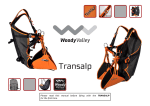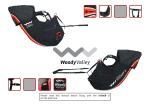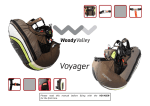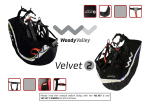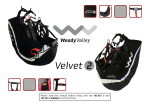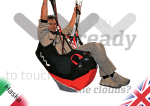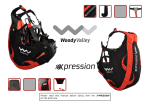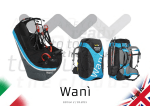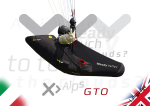Download Please read this manual before flying with the
Transcript
Please read this manual before flying with the PASSENGER for the first time. THANK YOU! We would like to thank you for having chosen one of our products, and we invite you to read this important document, the User Manual for the harness. Adjusting the harness. The harness forms the connection between the pilot and the passenger, and it is an essential component in optimizing the passenger’s pleasure during flight. We are conscious of the fact that reading an instruction manual is not an exciting experience. However, please remember that the respective product is not a citrus juicer or a mobile phone, and that correct use of the harness helps reduce the risk of flying accidents. This manual contains all the information necessary to assemble, adjust, fly and store your harness. Thorough knowledge of your equipment will improve your personal safety and your level of flying. The Woody Valley team SAFETY NOTE You have purchased a piece of equipment manufactured by us, and so you are aware of your identity as a paraglider pilot holding the respective pilot’s licence, and you accept all the risks connected to paragliding including the possibility of injury and death. The incorrect or inappropriate use of Woody Valley equipment greatly increases this risk. In no case can Woody Valley and the Woody Valley retailer be held responsible for personal injury caused to yourself or to third parties, or for whatever type of damage. If you have any doubts on the use of our equipment, please contact your retailer or the importer for your country. INDEX 1- GENERAL INFORMATION .................................................................................................................................................................................................................. 1 1.1- CONCEPT ....................................................................................................................................................................................................................................................................................1 1.2- PASSENGER PROTECTION .......................................................................................................................................................................................................................................................1 1.3- PASSENGER COMFORT................................................................................................................................................................................................................................................................2 2- BEFORE USING THE HARNESS ......................................................................................................................................................................................................... 3 2.1- HARNESS ADJUSTMENT ..............................................................................................................................................................................................................................................................3 2.1.1- Adjusting the sitting position ....................................................................................................................................................................................................................................3 2.1.2- Back position adjustment...........................................................................................................................................................................................................................................4 2.1.3- Shoulder-strap adjustment .......................................................................................................................................................................................................................................4 2.1.4- Chest strap adjustment ..............................................................................................................................................................................................................................................5 2.1.5- Leg strap adjustment ..................................................................................................................................................................................................................................................5 3- FLYING WITH THE PASSENGER HARNESS....................................................................................................................................................................................... 6 3.1- PRE-FLIGHT CHECKS ..................................................................................................................................................................................................................................................................6 3.2- POCKETS ....................................................................................................................................................................................................................................................................................6 3.3- FLYING ABOVE WATER.................................................................................................................................................................................................................................................................7 3.4- LANDING WITH THE PASSENGER ............................................................................................................................................................................................................................................7 4- FEATURES AND ASSEMBLY OF OPTIONAL ACCESSORIES .............................................................................................................................................................. 7 4.1- RELAX-BAR .................................................................................................................................................................................................................................................................................7 5- MAINTENANCE AND REPAIR ............................................................................................................................................................................................................ 8 6- TECHNICAL DATA ............................................................................................................................................................................................................................. 9 7- CERTIFICATE OF APPROVAL .......................................................................................................................................................................................................... 10 1- GENERAL INFORMATION The equipment supplied should contain: - Harness - Wooden seat plate - Hook-in karabiners The optional extras comprise: - Relax-bar 1.1- Concept PASSENGER è is a product that was developed wholly by Woody Valley to meet the demands specifically expressed by our pilots. This paragliding harness is very light, and it was designed to optimize comfort for passengers in dual flight. It has many adjustment possibilities, and so it is suitable for all types of individual. PASSENGER is a simple and lightweight harness, designed for maximum comfort and simplicity of use. It is easy to carry around when not in the air. 1.2- PASSENGER protection The airbag provides excellent protection in case of impact. The advanced structure based on semi-rigid compartments makes it possible to achieve about 60/70% of total protection even without complete inflation, which occurs only during the launch phase. Chest-straps and leg-straps are fitted with the “GET-UP safety system” to prevent the passenger from sliding out of the harness in the case that the pilot has forgotten to fasten the leg-straps. 1 When folding the harness, make sure that the padded section around the airbag inflation valve does not suffer any tight folds which could eventually mar its correct functioning The airbag protection system is also covered with reinforced fabric which helps reduce damage caused by any abrasion to which the harness may be subjected. 1.3- Passenger comfort The two red handles on the main harness straps make it simple and obvious even for the most inexperienced passengers to adopt the correct position in flight after launch. 2 2- BEFORE USING THE HARNESS 2.1- Harness adjustment The PASSENGER harness provides many adjustment possibilities ensuring that the passenger flies in the best possible position. To adjust the harness to the best possible position, we suggest that the passenger hangs in the harness from a suitable point of support, simulating flying position and conditions. For this reason, it is best to place all the things that would normally be carried when flying into the back pocket (rucksack, accessories, extra clothing and other sundry items). 2.1.1- Adjusting the sitting position The first adjustment procedure regulates the angle between the thighs and the back (depth of seat). This angle can be varied from about 90° to 130°, by adjusting the straps running through the lateral trimmers. The lateral straps help you adjust the sitting angle, and they provide leg support on long flights. 3 2.1.2- Back position adjustment By adjusting the back (using the trimmers higher up on the side), the pilot adjusts the inclination of the torso with respect to the vertical axis in flight. A good flying position, improving control of the glider, is obtained by positioning the face at about 15 cm from an imaginary line between the two karabiners. 2.1.3- Shoulder-strap adjustment Shoulder-strap adjustment enables the harness to be adjusted to the pilot’s height. The adjustment buckle is situated low down, near the rear edge of the seat. The shoulder-straps also support part of the torso weight to improve comfort. 4 2.1.4- Chest strap adjustment The chest strap adjusts the distance between the two karabiners, and it can be set between 37 and 48 centimetres. When the chest strap is tighter, stability is greater. We recommend a length of about 40-42 cm. A wider distance does not improve glider performance, and a smaller distance can accentuate the effects of a “twist” following an asymmetric collapse. There is also a small elastic clip at the extremity of the padded shoulder-straps. This prevents the shoulders from slipping out of the straps during the launch run. The plastic clip also includes a useful whistle that can be used in emergency situations. 2.1.5- Leg strap adjustment The fact that the leg straps are attached to the harness relatively high up ensures great freedom of movement for the passenger’s legs. PASSENGER is fitted with an adjustment buckle that is easy to adjust in accordance with the passenger’s body shape. IMPORTANT All adjustments have to be performed symmetrically on both sides. 5 3- FLYING WITH THE PASSENGER HARNESS 3.1- Pre-flight checks For maximum safety, use a complete and consistent system of pre-flight checks and repeat the same mental sequence every flight. Check that: all buckles are fastened. Take particular care in the case of ice or snow. Always clean off snow or ice before fastening buckles; the reserve parachute handle is fastened in its correct position, and the pins are firmly inserted; pockets and zips are closed; the paraglider is connected correctly to the harness, and that both karabiners are locked closed by means of their locking system; the speed bar is attached correctly to the glider. 3.2- Pockets PASSENGER has a large dorsal storage compartment and small lateral pockets, arranged so that contents cannot fall out during flight even if pockets are left open. The top of the dorsal compartment has a Velcro cover, so that the pilot can use it can as an instrument compartment. 6 3.3- Flying above water It is inadvisable to use the PASSENGER harness on flights over water. In the event of the pilot being forced to land on the water, the airbag, which is filled with air, may force the harness into a position that holds the pilot underwater. Woody Valley recommends the use of a suitable lifejacket when flying over water. 3.4- Landing with the PASSENGER Before landing, slide your legs out and off the seat surface, so that you take up a standing position. Never land in the seated position; it is very dangerous for your back even if you have an airbag, which provide exclusively passive protection. Standing up before landing is an active safety precaution, and it is much more effective than passive forms of protection. 4- FEATURES AND ASSEMBLY OF OPTIONAL ACCESSORIES 4.1- Relax-bar A relax-bar can be fitted to all our harnesses, except for those already incorporating this accessory. The relax-bar is used to keep the legs stretched out and the feet resting on a support. Some pilots consider this flying position as more comfortable than the classic seated position with legs hanging. To attach the relax bar to the harness, follow the instructions provided in the relax-bar instruction manual. 7 5- MAINTENANCE AND REPAIR Check the harness after every impact, bad landing or launch, or in the case that there are signs of damage or excessive wear. Periodically ensure that the airbag valve and cover are in perfect condition, above all after any impacts. We recommend having your harness checked by your retailer every two years, and replacing the main karabiners every two years. To prevent unnecessary wear and deterioration of the harness, it is important to avoid its scraping against the ground, rocks or abrasive surfaces. Do not expose the harness unnecessarily to UV radiation (sunlight) outside normal flying activities. Wherever possible, protect the harness from humidity and heat. Store all your paragliding equipment in a cool, dry place, and never put it away while damp or wet. Keep your harness as clean as possible by regularly cleaning off dirt with a plastic bristle brush and/or a damp cloth. If the harness gets exceptionally dirty, wash it with water and a mild soap. Allow the harness to dry naturally in a well-ventilated area away from direct sunlight. Repairs and replacement of harness components cannot be performed by the user, but exclusively by the manufacturer or staff authorized by the manufacturer. The manufacturer and authorized service staff alone can use materials and techniques ensuring correct product functionality and its complete conformity to product certification. The harness can be washed using a tepid solution of water and mild soap. Zip fasteners should be kept clean and lubricated with silicone spray. In the case of making any request to an official retailer or Woody Valley for maintenance operations, please quote the complete identification number shown on the silver label in the rear pocket. We hope that you enjoy great flights and happy landings with PASSENGER ! 8 6- TECHNICAL DATA DHV tested for a maximum load of 100 kg Distance between karabiner and seat One size cm 46 Distance between karabiners (min. max.) One size cm 40/51 Size of wooden seat, one size Width 36 cm; depth. 37 cm Total weight of PASSENGER, complete with karabiners 3,20 kg Type of protection AIRBAG protection Type of straps GET-UP safety system Certification DHV DHV GS-03-0340-06 9 7- CERTIFICATE OF APPROVAL Every effort has been made to ensure that the information contained in this manual is correct, but please remember that it has been produced for guidance only. This owner's manual is subject to change without prior notice. Please check at www.woodyvalley.com for the latest information regarding the PASSENGER harness. Latest update: APRIL 2010 10













